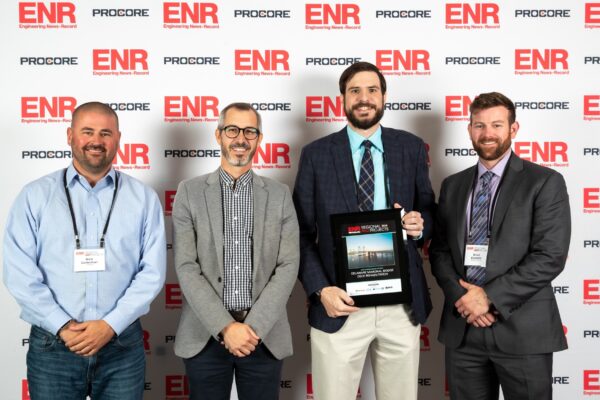Combination Protection from Corrosion Using DCI® and FORCE® 10,000® – TB-0904

At the high pH of concrete, about 12.5, a passivating oxide forms on the surface of reinforcement, providing protection from corrosion. As aggressive ions such as chloride (Cl-) reach the steel, this oxide breaks down and corrosion begins. The corrosion of steel is an expansive reaction, resulting in tensile stresses that cause concrete cracking and spalling.
Two methods of protection may be used to inhibit the corrosion of steel in concrete. They are:
- Chloride ion barriers
- Chemical changes at the steel surface
The chloride ion barriers method was designed to slow the movement of chloride ions through the concrete. In most circumstances, when chloride ions diffuse through the concrete from an outside source, the corrosion rate of the steel is directly related to the concentration of chloride ions at the steel surface. By delaying the ingress of Cl-, the initiation of corrosion is delayed. Changing the chemistry at the steel surface can provide corrosion protection even in the presence of chloride ions. This method is useful for situations where the chloride ion source is outside of the concrete or where the chloride ions have been added to concrete during the mixing process.
Admixtures for Fresh Concrete
Two admixtures are available that provide corrosion protection for steel embedded in concrete. FORCE® 10,000D Microsilica protects steel by decreasing the chloride ion permeability of the concrete. It may be added to concrete as a liquid slurry or a dry-densified powder. The small, spherical silica particles fill voids in the concrete and chemically react with Ca(OH)2, reducing the permeability of the concrete. In addition, microsilica increases the strength, resistance to hydraulic abrasion-erosion and resistance to acid attack of concrete. For corrosion protection, it is added at a rate of 5% to 10% of the weight of cement in the mix. Details are found in FORCE® 10,000D Engineering Bulletins.
Calcium nitrite is the main component of a second admixture used to inhibit the corrosion of steel in concrete. DCI® Corrosion Inhibitor is a 30% calcium nitrite solution which changes the chemistry at the surface of the steel, controlling corrosion despite the presence of chloride ions in the concrete. As a result, the initiation of corrosion is delayed, and after corrosion begins, the corrosion rate of steel surrounded by the inhibitor is lower than the corrosion rate of other unprotected steel. Calcium nitrite is also added to concrete during the mix cycle. A natural accelerator, the set time of concrete containing this admixture may have to be adjusted with a retarder.
Dosage
The recommended dosage of both microsilica and calcium nitrite depend on the severity of the corrosive environment, the concrete mix design and the specified concrete cover over the reinforcement. A common test method for determining an effective dosage of microsilica is the rapid chloride permeability test procedure found in AASHTO T277 and ASTM C1202. The test results are reported in terms of “coulombs”, a function of
concrete resistivity. For corrosion protection, enough microsilica should be added to produce concrete which has a reading in the low category, or less than 1,000 coulombs. This dosage ranges from 5 to 15% by weight of cement used.
The recommended dosage of calcium nitrite solution is a function of the chloride ion concentration to be found at the steel. A higher expected concentration requires a larger addition of DCI®. The dosage ranges from 9.8 to 29.7 L/m3 (2 to 6 gal/yd3) of concrete. Concrete water/cement ratio and cover over steel both affect the recommended rate of addition. For details, see DCI® Engineering Bulletin 2.
The ASTM C1202 test should not be used when DCI® or DCI® S is also in the concrete. Calcium nitrite is an ionic salt that allows coulomb levels to rise, even though the concrete permeability does not change. For best results, run ASTM C1202 on the concrete with only the FORCE® 10,000D in the mix.
Combination System for Long-Range
Protection
FORCE® 10,000D and DCI® may be used together to greatly extend the life of reinforced, precast or prestressed concrete structures exposed to corrosive environments. These admixtures provide two different protection methods for steel embedded in concrete and deliver complementary performance. The same level of protection provided by each individual admixture is also provided when they are used together. FORCE® 10,000D Microsilica delays the ingress of chloride ions, extending the amount of time it takes for these ions to reach a concentration at which corrosion begins. DCI® provides protection to a specific concentration of Cl- at the reinforcement. It protect the steel as the concentration of chloride ions reach the critical corrosion value and beyond.
Recommended Addition Rates
When designing the concrete to be used in a structure that is subject to corrosion, ACI guidelines should be followed (see ACI 318, 201 and 357). They include:
- Low water/cement ratio (maximum 0.40)
- Adequate concrete cover (from 1.5 in. to 2.5 in. depending on the corrosive environment.)
- When specifying FORCE® 10,000D Microsilica and using the AASHTO T277 (ASTM C1202) test, the specification should call for a coulomb measurement in the “very low” category (less than 1,000 coulombs). Due to the significant degree of variability associated with coulomb testing, it is inappropriate to require a specific or unnecessarily low reading.
When DCI® is used in combination with microsilica, the dosage will vary, depending on the level of protection required. Typical dosage rates for a cubic yard of concrete for combination systems start at 5% FORCE® 10,000D + 9.8 L/m3 (2 gal/yd3) DCI®.





